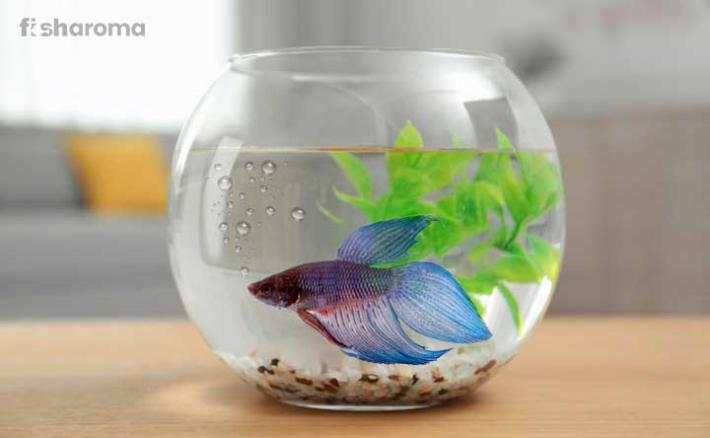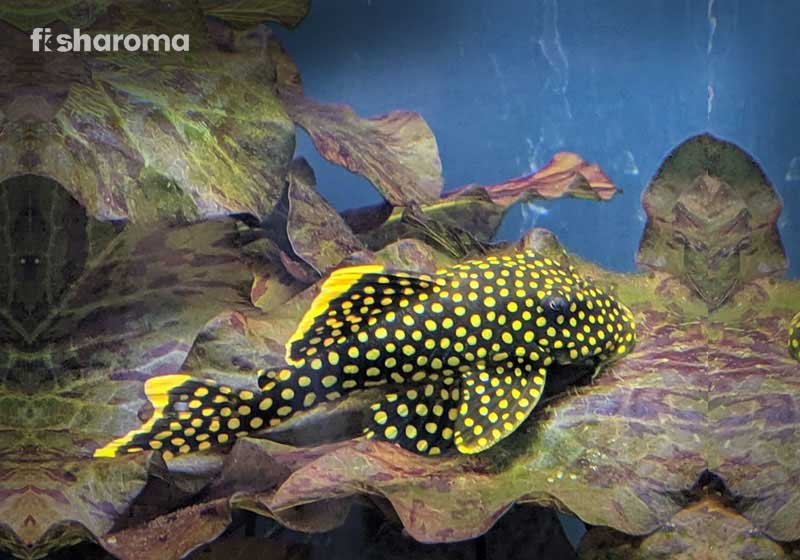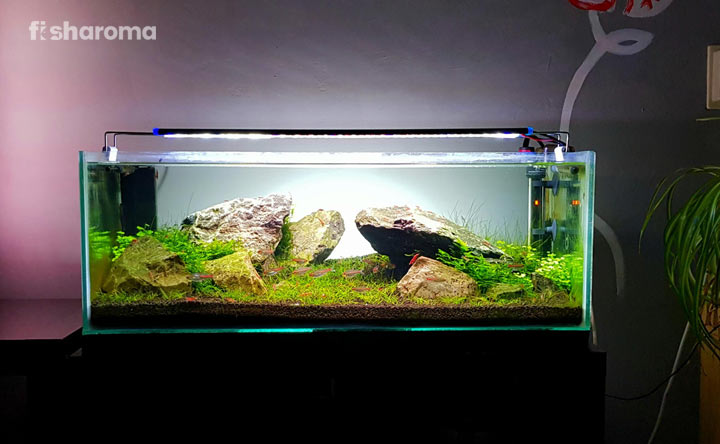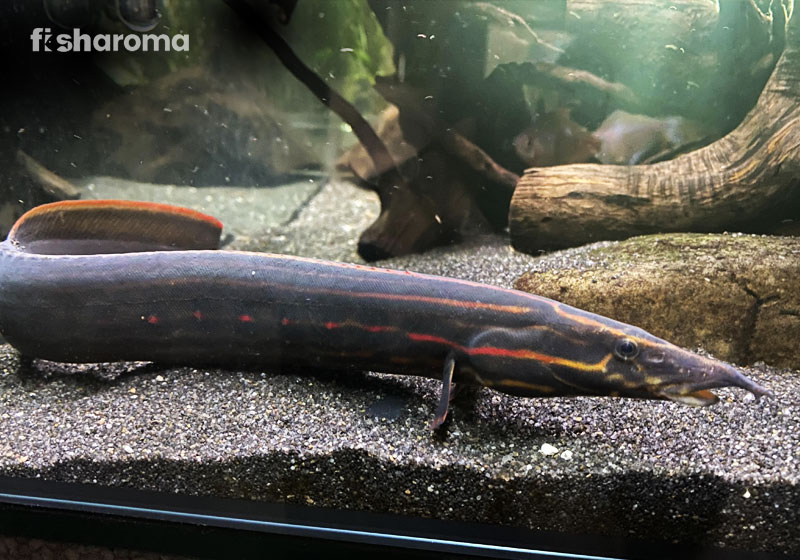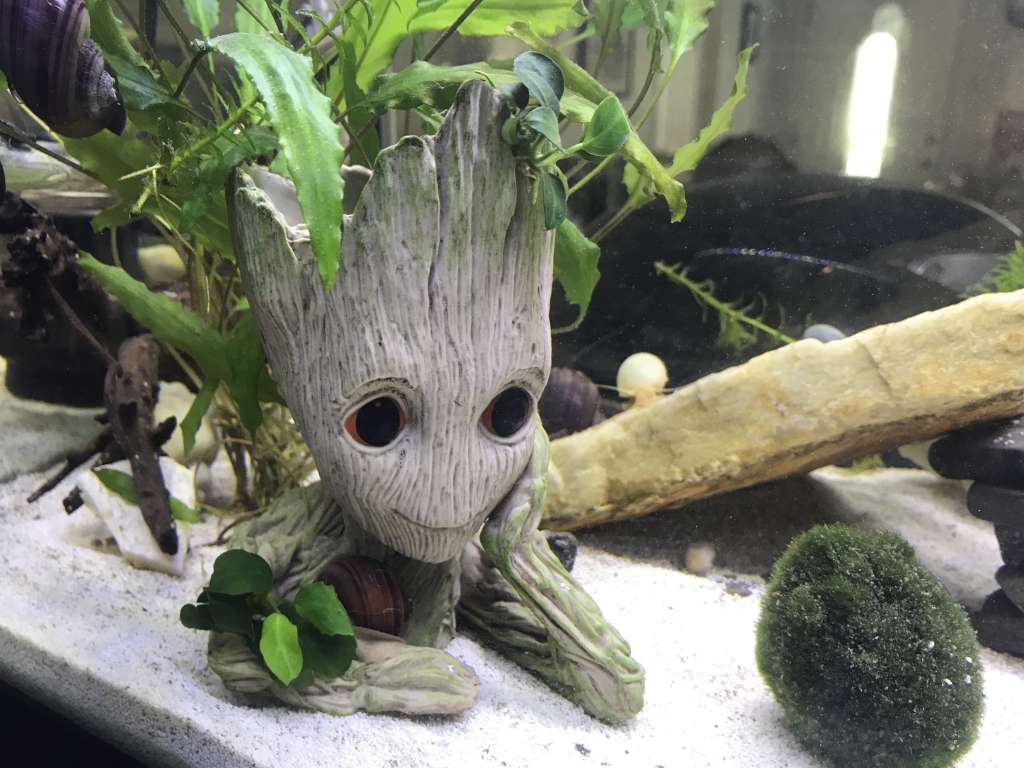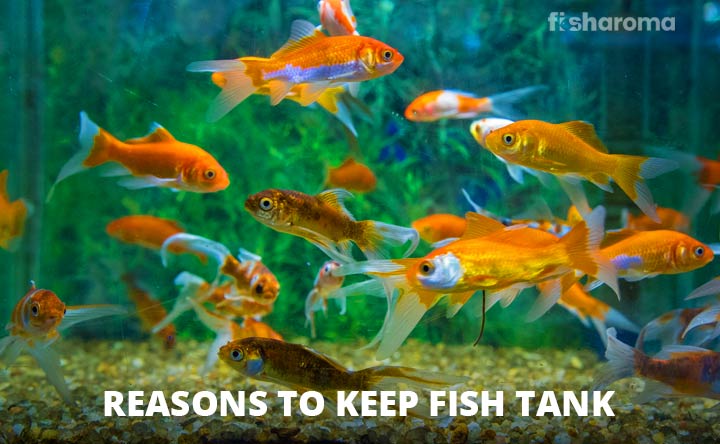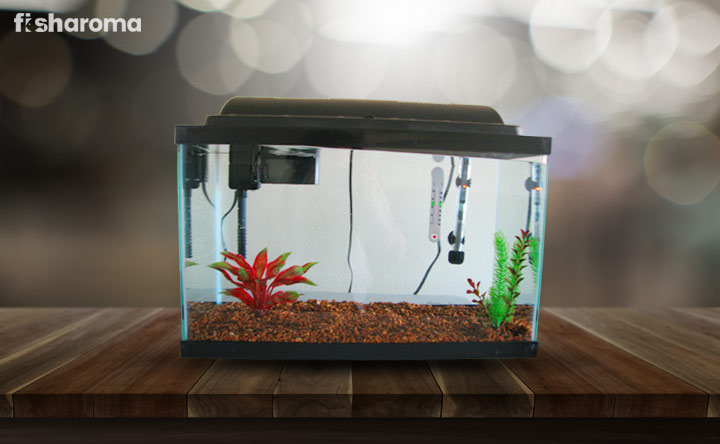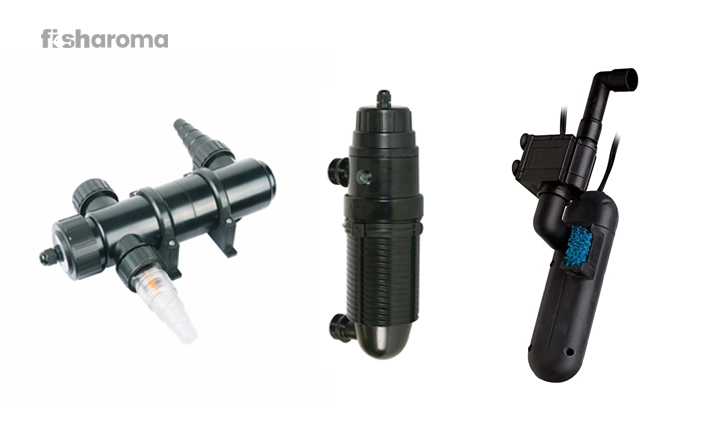75 Gallon Fish Tank – A Beginner’s Guide to This Large-Sized Tank
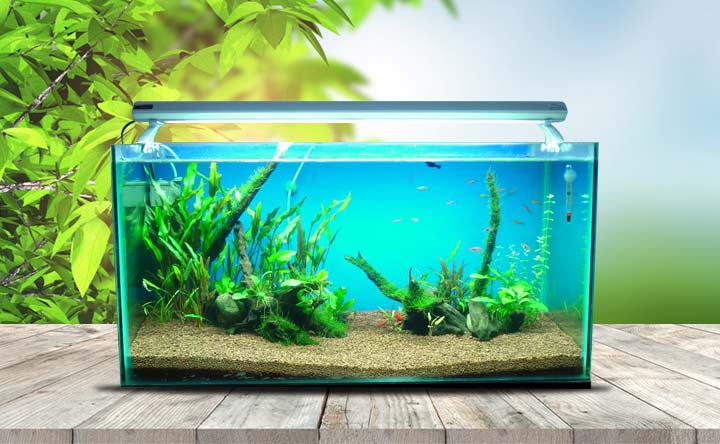
Fishkeeping is both challenging and rewarding, and the efforts that you need to put onto caring for fish can be quite strenuous. The challenge that you face heavily depends on the size of the tank. Many people feel afraid while switching from a small tank to a large tank. But, as a matter of fact, the transition is smoother than most people think it to be. A 75-gallon fish tank, for example, is the perfect gateway to large tanks for such people. Today, we are going to provide you with all the information that you need to attain before handling a tank of this size.
75 Gallon Fish Tank – An Overview
A 75-gallon tank will give you a lot of freedom to play around with. You can set it up as a freshwater tank, a saltwater tank, or even a cold water tank. The considerably large size of the tank will also act as a great asset that will add an aesthetic element to the room you keep it in.
Contrary to popular belief, maintaining a larger tank is easier than maintaining a small tank because the water parameters are more stable in a large volume of water. Thus, a large tank can be hosted by both a beginner and an expert aquarist.
Typically measuring 48x18x24” (120x45x60 cm), a 75-gallon fish tank is also the perfect playground for all those territorial fish that you can’t host in a small tank.
Types of Equipment in a 75-Gallon Fish Tank
Small tanks often come with a kit of their own that features heater, LED lighting system, and filtration. But, in case of a 75-gallon fish tank, you have to buy them separately since most of them aren’t sold with a kit. So, let’s take a look at the tank requirements of these aquariums.
Stand/Base
If you plan to keep your 75-gallon fish tank on an even surface at home, such as a sturdy cabinet, then you need to ensure that it is bigger than the dimension of your tank. Else, if you are going to buy a stand for your tank, it needs to be sturdy enough to uphold the heavy weight of your tank once filled with water.
Lighting
With a large tank, the lighting is much more elaborate than a small tank. This ensures that the interiors of your tank are properly illuminated and the aquatic pets and plants are properly visible from outside.
Make provisions for a natural lighting system that will incorporate a white light that will mimic daylight and a blue light that will mimic moonlight. For freshwater tanks, the ideal light rating should be 5,500-6,500 K, while for saltwater tanks, it should be 10,000 K.
The type of pets and plants you keep in your tank would also dictate the type of lighting you need to keep in your tank.
Having timers would automatically set on and off the lights and change the lighting type in order to replicate the natural environment of your pets. Try to include it if you have don’t want to deal with the hassle of switching the lights on and off on a daily basis.
A high lighting system encourages algae growth, so keep that in mind while selecting the lights of your home.
Filtration
Filters are critical for the survival of your aquatic pets. They have a multi-faceted job wherein they aerate (oxygenate) the water and also remove fish wastes and debris, thereby clearing out toxins from the tank. In addition, they also create water flow in the tank. The water circulation generated by them helps in cleaning the tank on a continuous basis.
Depending on the type of your filter, you would have to replace the internal media of your filter from time to time. Their packaging indicates which tank size they are built for.
Heater
A large-sized aquarium like a 75-gallon tank requires a heater so that the stability of the temperature of the tank water is maintained. Much like lighting, the temperature that needs to set for the tank water will be dictated by the type of aquatic pets and plants you keep in your tank.
It is suggested that you keep a backup heater handy for these large tanks in case of an outage. If your heater doesn’t come with a temperature reading system, then you need to buy a submerged thermometer so that you can keep a track of the temperature.
Tank Lid
This is probably the only part of the equipment that you will get free of cost with the tank. Having a tank lid in your aquarium eliminates the risk of outside dusts and dirt getting accumulated inside the tank. In addition, if your house has any pet dogs and cats and any children, then a tank lid protects the aquatic pets from getting attacked by them.
Another underrated aspect of fishkeeping is that there are many fish that are known for leaping out of the water surface. In the absence of a tank lid, they will often fall out of the tank to meet their untimely death. You don’t want any such situation. Thus, using a firm lid is mandatory!
Substrate
The choice of substrate depends on what kind of pets you are having. For a freshwater tank, use gravel-based or mud-based substrate; whereas for a saltwater tank, go for sand-based substrate.
A gravel or mud-based substrate will allow beneficial bacteria to thrive, which will, in turn, help in cycling the tank. Always go for aquarium safe substrates to minimalize the risk of outside chemicals (present in ordinary substrate) affecting the health of your fish.
Décor
The humongous space of a 75-gallon tank will give you ample opportunities to go creative when it comes to the aquarium décor. Include caves, castles, rocks, driftwood, artificial plants (if you can’t commit to rearing live plants), and other quirky decorative items to accentuate the beauty of your tank.
However, don’t clutter it and block the free-swimming space of your fish.
Types of Fish to be kept in a 75-Gallon Fish Tank
The options of fish that you can keep in a 75-gallon tank are plenty, and even those species that are territorial by nature can live comparatively peacefully in such a large tank.
Some great choices for a 75-gallon tank are as follows:
- Weather Loach
- Marbled Hatchetfish
- Goldfish
- Zebra Danio
- Betta
- Oscar
- Silver Dollar
- Banggai Cardinalfish
- Mandarinfish
- Moorish Idol
- Regal Angelfish
- Clownfish
- Green Terror Cichlid
- Flowerhorn Cichlid
- Shrimps
- Snails
- Crabs
- Turtles
Remember, these are just some of the species that you can keep. There are still many other species that you can host in a 75-gallon fish tank.
Type of Tank
Whether you keep it as a species-only tank or community tank is completely up to you. Hosting a bunch of fish, all belonging to the same species can create a distinct look in your tank. For example, 4-5 Electric Blue Acaras or 25-30 Neon Tetras will look spectacular.
In case of a community tank, you need to ensure that the species that you are keeping together are compatible by nature. You don’t want your 75-gallon fish tank to turn into a battlefield!
A community tank could comprise of a pair of Angelfish, a few Marbled Hatchetfish for the top level, a bunch of Zebra Danios for the mid-level, and a couple of Kuhli Loaches for the bottom level of the aquarium. Feel free to change up the combination as long as they are compatible with each other.
In addition, you can also use this tank to make a paludarium, hosting a bunch of terrestrial and aquatic plants. This semi-aquatic habitat can also host terrestrial and aquatic species, especially those who can live both on land and underwater, such as crabs, turtles, snails, among others.
How to set up a 75-Gallon Fish Tank
After buying the 75-gallon tank, your first job is to clean it with a dry soft cloth to get rid of the dust. In case of a second-hand tank, use a solution of warm water and vinegar to wipe off the interiors.
Select the location for your tank and place it over the stand. Next, rinse the substrate by putting it under running tap water. This will ensure that the tank water doesn’t get cloudy.
Add the substrate at the bottom of the tank. Usually 1-2” (2.5-5 cm) of substrate will suffice. Proceed to place all your equipment in their respective places. However, don’t turn them on.
Next, you need to fill up your tank with water. But don’t just dump the water from a bucket or through a pipe directly over the substrate. This will disrupt the substrate and ornaments and make the tank water murky. To avoid such a situation, place a saucer and pour the water over it. It will keep the substrate stable.
Don’t fill up the tank all the way. Leave some space since the water level will inadvertently rise once you add in the fish later. If you are using tap water, remember to add dechlorinator. The dosage of the dechlorinator that you would need to add will depend on the quantity of water, which will be mentioned on its package.
Quarantining everything you put in a tank is of utmost importance. This includes everything from the substrate, ornaments, and even your fish. This eliminates the chances of outside infections affecting the health of your fish.
Cycling the Tank
Cycling a tank before you add any aquatic pet like is extremely essential. It helps in the growth of the beneficial bacteria that are needed to create a safe and healthy environment inside your tank. It usually takes up to six weeks for these bacteria to grow.
The tank water will cycle itself. All you need to do is check the levels of ammonia, nitrite, and nitrate from time to time with the help of a water testing kit. Two weeks after adding the water, the level of nitrite will spike, before reducing again. After the period of six weeks, if the level of ammonia and nitrite stands at 0 ppm, then it is time for fish to be added.
Adding Fish to the Tank
You just can’t buy fish from the market and dump them directly in your tank. First of all, quarantine them in a separate small tank. After that, you need to let them acclimatize with the tank environment.
If possible, try to introduce them in small numbers. Keep the fish in a plastic bag that is filled with water from the quarantine tank. Dim the lights of your main tank and let the bag float for around 15-20 minutes so that it gets similar to the temperature inside the main tank.
Next, after 15-20 minutes, open the plastic bag and pour a bit of tank water in it and close it again. Repeat this process 4-5 times every ten minutes. If the fish is reacting normally to it, then it’s time to add the fish to the tank.
Keep a close watch on them for the next 2-3 weeks to notice any irregular behavior or discomfort. If you notice something, consult a veterinarian immediately.
Summary
A 75-gallon aquarium can be quite intimidating at first glance. However, they are much easier to maintain than a small tank. Even a beginner aquarist can host them with much ease. If you follow this step-by-step guide to set up the tank, your fishkeeping experience will go smoothly, like carving a knife through butter.
The range of options of species that you can keep in these tanks is pretty wide because you can host territorial species in this tank that can’t be hosted otherwise. In fact, they make for great community tanks as well. So, get your 75-gallon fish tank and experience fishkeeping in a spectacular fashion.
Similar Fishkeeping Guides
Take a look at some of our other similar fishkeeping articles that fall in the same line as this article.
- Best 10-Gallon Tank – If you don’t have the space to host a 10-gallon tank and are looking for small tanks, this 10-gallon tank guide might come in handy.
- Best Goldfish Tank – Give your Goldfish the beautiful home it deserves from our recommendations of the best Goldfish tanks available in the market.
- How to Decide the Best Fish Tank Size for You? – Learn from us which fish tank size is more suited for your needs.

